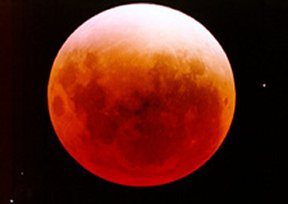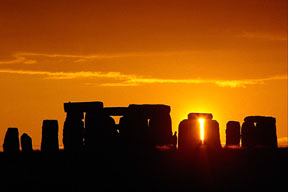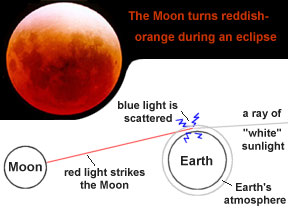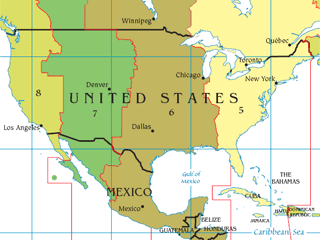This image explains how the Earth's shadow causes a lunar eclipse. Notice the difference between the umbra and the penumbra.
Click on image for full size
Windows to the Universe original image
Lunar Eclipses
Lunar eclipses are special events that only occur when certain conditions are met. First of all, the Moon must be in full phase. Secondly, the Sun, Earth and Moon must be in a perfectly straight line. If both of these are met, then the Earth's shadow can block the Sun's light from hitting the Moon.
There are three types of lunar eclipses. Which one we will see depends on the alignment of the three celestial objects. But first, you need to know that the Earth's shadow is broken up into two parts. The umbra is the darker part of the shadow, where no part of the Sun can been seen. The penumbra is lighter than the umbra, because part of the Sun can be seen.
So, when part of the Moon passes through the umbra, this is called a partial eclipse. When all of the Moon passes through the umbra, this is called a total eclipse. Finally, when the Moon only passes through the penumbra, this is called a penumbral eclipse.
Now that you know all about eclipses, you can step outside and enjoy the show! Remember that lunar eclipses are not dangerous to the eye, so you don't need protection to watch. Just find a nice, cozy spot and enjoy!
You might also be interested in:

The last lunar eclipse of the millennium in North America is this week! On January 20, 2000, which is Thursday for those living in North America, a total lunar eclipse will occur. A lunar eclipse is different
...more
Some people would say that advanced astronomical astronomy was practiced at Stonehenge. But, it is not likely that ancient observers were able to make advanced predictions such as when lunar and solar
...more
There will be an eclipse of the Moon on Thursday night, May 15, 2003. It will be the first eclipse in 2003. This eclipse is a total eclipse of the Moon, which means the Moon will pass through the darkest
...more
There will be an eclipse of the Moon on Saturday night, November 8, 2003. It will be the second lunar eclipse in 2003. This eclipse is a total eclipse of the Moon, which means the Moon will pass through
...more
There will be an eclipse of the Moon on Wednesday night, October 27, 2004 (or during the wee hours of the morning on the 28th if you are in Europe or Africa). This eclipse is a total eclipse of the Moon,
...more
When it is noon where you live, it is midnight on the opposite side of the world. Usually when we think of time, we mean "the time of day where I live". If we say something happened at 9 AM, we mean it
...more












